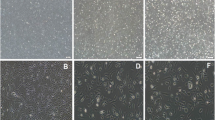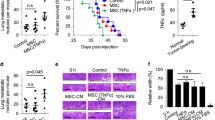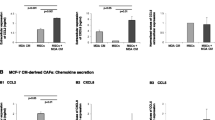Abstract
Epithelial-mesenchymal transition (EMT) is an essential process in breast cancer metastasis. The aim of the present study was to determine the role of secretions of tumor-associated leukocytes (TALs) isolated from negative and positive lymph nodes (nLNs and pLNs, respectively) breast cancer patients in regulating EMT mechanism and the associated signaling pathways. We found an increased infiltration of TALs, which was associated with downregulation of E-cadherin and over-expression of vimentin in the breast carcinoma tissues of pLNs as compared to nLNs patients and normal breast tissues obtained from healthy volunteers during mammoplasty. Furthermore, TALs isolated from pLNs breast cancer patients secreted an elevated panel of cytokines by up to 2–5-fold when compared with those isolated from nLNs patients. Secretome of TALs of pLNs possessed higher TARC, IGF-1, IL-3, TNF-β, IL-5, G-CSF, IL-4, and IL-1α with more than a fivefold compared to those of nLNs. Using the human breast cancer cell lines MCF-7 and MDA-MB-231, we found that cytokines secreted by TALs isolated from nLNs and pLNs breast cancer patients promoted EMT via upregulation of TGF-β and vimentin and downregulation of E-cadherin at messenger RNA (mRNA) levels in both cell lines and at protein level in MCF-7. While TGF-β is over-expressed by MDA-MB-231 seeded in media conditioned by secretome of TALs isolated from nLNs and pLNs breast cancer patients. The downstream TGF-β signaling transcription factors, Snail, Slug, and Twist, known to be associated with EMT mechanism were over-expressed by MCF-7 and MDA-MB-231 seeded in media conditioned by secretome of TALs isolated from nLNs and pLNs breast cancer patients. Acquisition of EMT in MCF-7 cells is mechanistically attributed to the activation of EGFR(Tyr845) and NF-κB/p65(Ser276) signaling which are significantly highly expressed by MCF-7 cells seeded in media conditioned by secretome of TALs isolated from pLNs compared to nLNs patients. Overall, this study provides implications of secretome of TALs and activated EGFR(Tyr845) and NF-κB/p65(Ser276) in EMT process that may be considered a therapeutic strategy to inhibit lymph node metastasis in breast cancer patients.





Similar content being viewed by others
References
Eccles SA, Welch DR. Metastasis: recent discoveries and novel treatment strategies. Lancet. 2007;369(9574):1742–57. doi:10.1016/S0140-6736(07)60781-8.
Shook D, Keller R. Mechanisms, mechanics and function of epithelial-mesenchymal transitions in early development. Mech Dev. 2003;120(11):1351–83.
Visvader JE, Lindeman GJ. Cancer stem cells in solid tumours: accumulating evidence and unresolved questions. Nat Rev Cancer. 2008;8(10):755–68. doi:10.1038/nrc2499.
Thiery JP, Acloque H, Huang RY, Nieto MA. Epithelial-mesenchymal transitions in development and disease. Cell. 2009;139(5):871–90. doi:10.1016/j.cell.2009.11.007.
Lamouille S, Xu J, Derynck R. Molecular mechanisms of epithelial-mesenchymal transition. Nat Rev Mol Cell Biol. 2014;15(3):178–96. doi:10.1038/nrm3758.
Medici D, Hay ED, Olsen BR. Snail and slug promote epithelial-mesenchymal transition through beta-catenin-T-cell factor-4-dependent expression of transforming growth factor-beta3. Mol Biol Cell. 2008;19(11):4875–87. doi:10.1091/mbc.E08-05-0506.
Scheel C, Weinberg RA. Cancer stem cells and epithelial-mesenchymal transition: concepts and molecular links. Semin Cancer Biol. 2012;22(5–6):396–403. doi:10.1016/j.semcancer.2012.04.001.
Wang X, Wang H, Li G, Song Y, Wang S, Zhu F, et al. Activated macrophages down-regulate expression of E-cadherin in hepatocellular carcinoma cells via NF-kappaB/slug pathway. Tumour Biol. 2014;35(9):8893–901. doi:10.1007/s13277-014-2159-7.
Huber MA, Azoitei N, Baumann B, Grunert S, Sommer A, Pehamberger H, et al. NF-kappaB is essential for epithelial-mesenchymal transition and metastasis in a model of breast cancer progression. J Clin Invest. 2004;114(4):569–81.
Huber MA, Beug H, Wirth T. Epithelial-mesenchymal transition: NF-kappaB takes center stage. Cell Cycle. 2004;3(12):1477–80.
Shostak K, Chariot A. NF-kappaB, stem cells and breast cancer: the links get stronger. Breast Cancer Res. 2011;13(4):214. doi:10.1186/bcr2886.
Scartozzi M, Bearzi I, Pierantoni C, Mandolesi A, Loupakis F, Zaniboni A, et al. Nuclear factor-kB tumor expression predicts response and survival in irinotecan-refractory metastatic colorectal cancer treated with cetuximab-irinotecan therapy. J Clin Oncol. 2007;25(25):3930–5. doi:10.1200/JCO.2007.11.5022.
El-Ghonaimy EA, El-Shinawi M, Ibrahim SA, El-Ghazaly H, Abd-El-Tawab R, Nouh MA, et al. Positive lymph-node breast cancer patients—activation of NF-kappaB in tumor-associated leukocytes stimulates cytokine secretion that promotes metastasis via C-C chemokine receptor CCR7. FEBS J. 2015;282(2):271–82. doi:10.1111/febs.13124.
Mohamed MM, El-Ghonaimy EA, Nouh MA, Schneider RJ, Sloane BF, El-Shinawi M. Cytokines secreted by macrophages isolated from tumor microenvironment of inflammatory breast cancer patients possess chemotactic properties. Int J Biochem Cell Biol. 2014;46:138–47. doi:10.1016/j.biocel.2013.11.015 S1357-2725(13)00353-1.
Al-Raawi D, Abu-El-Zahab H, El-Shinawi M, Mohamed MM. Membrane type-1 matrix metalloproteinase (MT1-MMP) correlates with the expression and activation of matrix metalloproteinase-2 (MMP-2) in inflammatory breast cancer. Int J Clin Exp Med. 2011;4(4):265–75.
Nouh MA, Mohamed MM, El-Shinawi M, Shaalan MA, Cavallo-Medved D, Khaled HM, et al. Cathepsin B: a potential prognostic marker for inflammatory breast cancer. J Transl Med. 2011;9:1. doi:10.1186/1479-5876-9-1.
El-Shinawi M, Abdelwahab SF, Sobhy M, Nouh MA, Sloane BF, Mohamed MM. Capturing and characterizing immune cells from breast tumor microenvironment: an innovative surgical approach. Ann Surg Oncol. 2010;17(10):2677–84. doi:10.1245/s10434-010-1029-9.
Bradford MM. A rapid and sensitive method for the quantitation of microgram quantities of protein utilizing the principle of protein-dye binding. Anal Biochem. 1976;72:248–54.
Mohamed MM, Cavallo-Medved D, Rudy D, Anbalagan A, Moin K, Sloane BF. Interleukin-6 increases expression and secretion of cathepsin B by breast tumor-associated monocytes. Cell Physiol Biochem. 2010;25(2–3):315–24. doi:10.1159/000276564.
Ibrahim SA, Hassan H, Vilardo L, Kumar SK, Kumar AV, Kelsch R, et al. Syndecan-1 (CD138) modulates triple-negative breast cancer stem cell properties via regulation of LRP-6 and IL-6-mediated STAT3 signaling. PLoS One. 2013;8(12):e85737. doi:10.1371/journal.pone.0085737.
Serrano-Gomez SJ, Maziveyi M, Alahari SK. Regulation of epithelial-mesenchymal transition through epigenetic and post-translational modifications. Mol Cancer. 2016;15:18. doi:10.1186/s12943-016-0502-x.
Yu S, Yan C, Yang X, He S, Liu J, Qin C, et al. Pharmacoproteomic analysis reveals that metapristone (RU486 metabolite) intervenes E-cadherin and vimentin to realize cancer metastasis chemoprevention. Sci Rep. 2016;6:22388. doi:10.1038/srep22388.
Shostak K, Zhang X, Hubert P, Goktuna SI, Jiang Z, Klevernic I, et al. NF-kappaB-induced KIAA1199 promotes survival through EGFR signalling. Nat Commun. 2014;5:5232. doi:10.1038/ncomms6232.
Nathanson SD. Insights into the mechanisms of lymph node metastasis. Cancer. 2003;98(2):413–23.
Jatoi I, Hilsenbeck SG, Clark GM, Osborne CK. Significance of axillary lymph node metastasis in primary breast cancer. J Clin Oncol. 1999;17(8):2334–40.
Markiewicz A, Welnicka-Jaskiewicz M, Seroczynska B, Skokowski J, Majewska H, Szade J, et al. Epithelial-mesenchymal transition markers in lymph node metastases and primary breast tumors—relation to dissemination and proliferation. Am J Transl Res. 2014;6(6):793–808.
Shriver CD, Hueman MT, Ellsworth RE. Molecular signatures of lymph node status by intrinsic subtype: gene expression analysis of primary breast tumors from patients with and without metastatic lymph nodes. J Exp Clin Cancer Res. 2014;33(1):782. doi:10.1186/s13046-014-0116-3.
DeNardo DG, Johansson M, Coussens LM. Immune cells as mediators of solid tumor metastasis. Cancer Metastasis Rev. 2008;27(1):11–8.
Cao YW, Wan GX, Sun JP, Cui XB, Hu JM, Liang WH, et al. Implications of the Notch1-snail/slug-epithelial to mesenchymal transition axis for lymph node metastasis in infiltrating ductal carcinoma. Kaohsiung J Med Sci. 2015;31(2):70–6. doi:10.1016/j.kjms.2014.11.008.
Grzegrzolka J, Biala M, Wojtyra P, Kobierzycki C, Olbromski M, Gomulkiewicz A, et al. Expression of EMT markers Slug and Twist in breast cancer. Anticancer Res. 2015;35(7):3961–8.
Cho HJ, Park SM, Kim IK, Nam IK, Baek KE, Im MJ, et al. RhoGDI2 promotes epithelial-mesenchymal transition via induction of snail in gastric cancer cells. Oncotarget. 2014;5(6):1554–64. doi:10.18632/oncotarget.1733.
Kang R, Zhao S, Liu L, Li F, Li E, Luo L, et al. Knockdown of PSCA induces EMT and decreases metastatic potentials of the human prostate cancer DU145 cells. Cancer Cell Int. 2016;16:20. doi:10.1186/s12935-016-0295-4.
Ricciardi M, Zanotto M, Malpeli G, Bassi G, Perbellini O, Chilosi M, et al. Epithelial-to-mesenchymal transition (EMT) induced by inflammatory priming elicits mesenchymal stromal cell-like immune-modulatory properties in cancer cells. Br J Cancer. 2015;112(6):1067–75. doi:10.1038/bjc.2015.29.
Amin A, Mokhdomi TA, Bukhari S, Wani SH, Wafai AH, Lone GN, et al. Tectorigenin ablates the inflammation-induced epithelial-mesenchymal transition in a co-culture model of human lung carcinoma. Pharmacol Rep. 2015;67(2):382–7. doi:10.1016/j.pharep.2014.10.020.
Al-haidari AA, Syk I, Jirstrom K, Thorlacius H. CCR4 mediates CCL17 (TARC)-induced migration of human colon cancer cells via RhoA/rho-kinase signaling. Int J Color Dis. 2013;28(11):1479–87. doi:10.1007/s00384-013-1712-y.
Olkhanud PB, Baatar D, Bodogai M, Hakim F, Gress R, Anderson RL, et al. Breast cancer lung metastasis requires expression of chemokine receptor CCR4 and regulatory T cells. Cancer Res. 2009;69(14):5996–6004. doi:10.1158/0008-5472.CAN-08-4619.
Li CW, Xia W, Huo L, Lim SO, Wu Y, Hsu JL, et al. Epithelial-mesenchymal transition induced by TNF-alpha requires NF-kappaB-mediated transcriptional upregulation of Twist1. Cancer Res. 2012;72(5):1290–300. doi:10.1158/0008-5472.CAN-11-3123.
Dinarello CA. Why not treat human cancer with interleukin-1 blockade? Cancer Metastasis Rev. 2010;29(2):317–29. doi:10.1007/s10555-010-9229-0.
Ji X, Li J, Xu L, Wang W, Luo M, Luo S, et al. IL4 and IL-17A provide a Th2/Th17-polarized inflammatory milieu in favor of TGF-beta1 to induce bronchial epithelial-mesenchymal transition (EMT). Int J Clin Exp Pathol. 2013;6(8):1481–92.
Cohen EN, Gao H, Anfossi S, Mego M, Reddy NG, Debeb B, et al. Inflammation mediated metastasis: immune induced epithelial-to-mesenchymal transition in inflammatory breast cancer cells. PLoS One. 2015;10(7):e0132710. doi:10.1371/journal.pone.0132710.
Zaynagetdinov R, Sherrill TP, Gleaves LA, McLoed AG, Saxon JA, Habermann AC, et al. Interleukin-5 facilitates lung metastasis by modulating the immune microenvironment. Cancer Res. 2015. doi:10.1158/0008-5472.CAN-14-2379.
Kowanetz M, Wu X, Lee J, Tan M, Hagenbeek T, Qu X, et al. Granulocyte-colony stimulating factor promotes lung metastasis through mobilization of Ly6G+Ly6C+ granulocytes. Proc Natl Acad Sci U S A. 2010;107(50):21248–55. doi:10.1073/pnas.1015855107.
Cui YH, Suh Y, Lee HJ, Yoo KC, Uddin N, Jeong YJ, et al. Radiation promotes invasiveness of non-small-cell lung cancer cells through granulocyte-colony-stimulating factor. Oncogene. 2015. doi:10.1038/onc.2014.466.
Julien S, Puig I, Caretti E, Bonaventure J, Nelles L, van Roy F, et al. Activation of NF-kappaB by Akt upregulates snail expression and induces epithelium mesenchyme transition. Oncogene. 2007;26(53):7445–56. doi:10.1038/sj.onc.1210546.
Wu Y, Deng J, Rychahou PG, Qiu S, Evers BM, Zhou BP. Stabilization of snail by NF-kappaB is required for inflammation-induced cell migration and invasion. Cancer Cell. 2009;15(5):416–28. doi:10.1016/j.ccr.2009.03.016.
Stanisavljevic J, Porta-de-la-Riva M, Batlle R, de Herreros AG, Baulida J. The p65 subunit of NF-kappaB and PARP1 assist Snail1 in activating fibronectin transcription. J Cell Sci. 2011;124(Pt 24):4161–71. doi:10.1242/jcs.078824.
Tsubaki M, Komai M, Fujimoto S, Itoh T, Imano M, Sakamoto K, et al. Activation of NF-kappaB by the RANKL/RANK system up-regulates snail and twist expressions and induces epithelial-to-mesenchymal transition in mammary tumor cell lines. J Exp Clin Cancer Res. 2013;32:62. doi:10.1186/1756-9966-32-62.
Jiang C, Lin X. Analysis of epidermal growth factor-induced NF-kappaB signaling. Methods Mol Biol. 2015;1280:75–102. doi:10.1007/978-1-4939-2422-6_6.
Lo HW, Hsu SC, Xia W, Cao X, Shih JY, Wei Y, et al. Epidermal growth factor receptor cooperates with signal transducer and activator of transcription 3 to induce epithelial-mesenchymal transition in cancer cells via up-regulation of TWIST gene expression. Cancer Res. 2007;67(19):9066–76. doi:10.1158/0008-5472.CAN-07-0575.
Corkery B, Crown J, Clynes M, O’Donovan N. Epidermal growth factor receptor as a potential therapeutic target in triple-negative breast cancer. Ann Oncol. 2009;20(5):862–7. doi:10.1093/annonc/mdn710.
Cai J, Tian AX, Wang QS, Kong PZ, Du X, Li XQ, et al. FOXF2 suppresses the FOXC2-mediated epithelial-mesenchymal transition and multidrug resistance of basal-like breast cancer. Cancer Lett. 2015;367(2):129–37. doi:10.1016/j.canlet.2015.07.001.
Acknowledgments
The authors would like to thank Dr. Hossam Taha Mohamed for assistance in conducting real-time PCR experiments. A special thanks to Dr. Alastair Hay, Professor of Environmental Toxicology School of Medicine University of Leeds, UK, for critical review of the English language.
Author information
Authors and Affiliations
Corresponding author
Ethics declarations
Conflicts of interest
None.
Funding
Authors Mohamed MM is supported by Avon Foundation USA and Cairo University scientific research sector and Ibrahim SA is supported by the German Academic Exchange Service (DAAD) Al Tawasul Project ID 5680846, EU H2020 MSCA-RISE GLYCANC and Science Technology Development Foundation (STDF) Reintegration project ID#6309.
Additional information
Eslam A. Elghonaimy and Sherif A. Ibrahim contributed equally to this work
Electronic supplementary material
Supplementary Table 1
(DOCX 11 kb)
Fig. S1
Expression level of total EGFR and NF-κB/p65 in breast cancer cell lines seeded in TALs condition media of nLNs and pLNs (TAL-CM-nLNs and TAL-CM-pLNs) patients. a Cell lysates (25 μg/lane) of MCF-7 and MDA-MB-231 cells seeded in control culture media, TAL-CM-nLNs and TAL-CM-pLNs were subjected to immunoblot analysis using antibodies against EGFR and NF-κB/p65 and β-actin as loading control. b Relative band intensities of EGFR and NF-κB/p65 were normalized to β-actin (50 kDa) expression. The data were analyzed using paired Student’s t test. Data represents mean ± SD. *p ≤ 0.05, **p ≤ 0.01, and ***represents p ≤ 0.001. Bands were visualized using ECL (Pierce, Paisley, UK) and BioSepctrum (UVP, Cambridge, UK) gel documentation system. (GIF 680 kb)
Rights and permissions
About this article
Cite this article
Elghonaimy, E.A., Ibrahim, S.A., Youns, A. et al. Secretome of tumor-associated leukocytes augment epithelial-mesenchymal transition in positive lymph node breast cancer patients via activation of EGFR/Tyr845 and NF-κB/p65 signaling pathway. Tumor Biol. 37, 12441–12453 (2016). https://doi.org/10.1007/s13277-016-5123-x
Received:
Accepted:
Published:
Issue Date:
DOI: https://doi.org/10.1007/s13277-016-5123-x




